BIOL 1108 Unit 3
1/51
There's no tags or description
Looks like no tags are added yet.
Name | Mastery | Learn | Test | Matching | Spaced |
|---|
No study sessions yet.
52 Terms
What are the three main reasons water important for plants?
They need it for…
Photosynthesis
Structure
Transport
Basic equation for photosynthesis
CO2 + Water + light = Glucose + oxygen
How does water relate to plant structure?
Turgor pressure — Created when a cell vacuole full of water exerts outward pressure on the cell wall
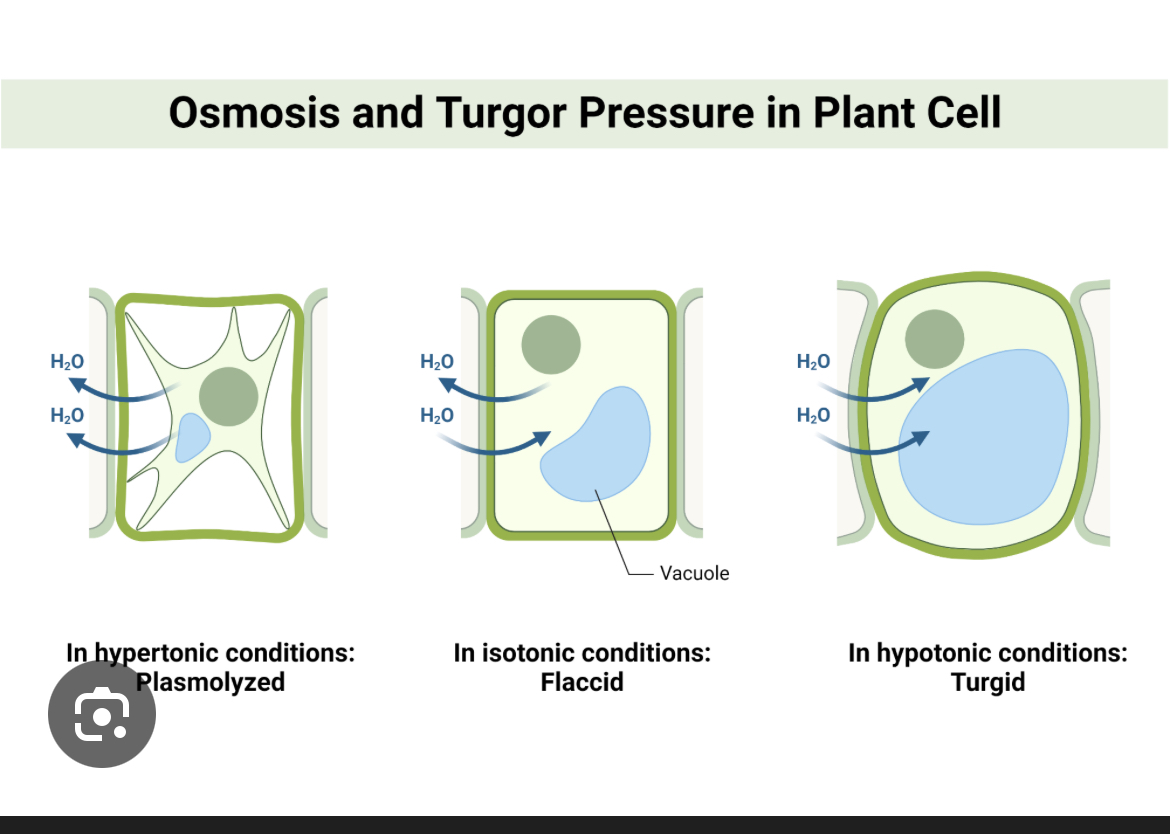
What are the two types of vascular tissue in plants?
Phloem and Xylem
What is phloem?
Vascular tissue that carries dissolved nutrients, hormones, sugars, etc. around a plant using osmosis (any direction)
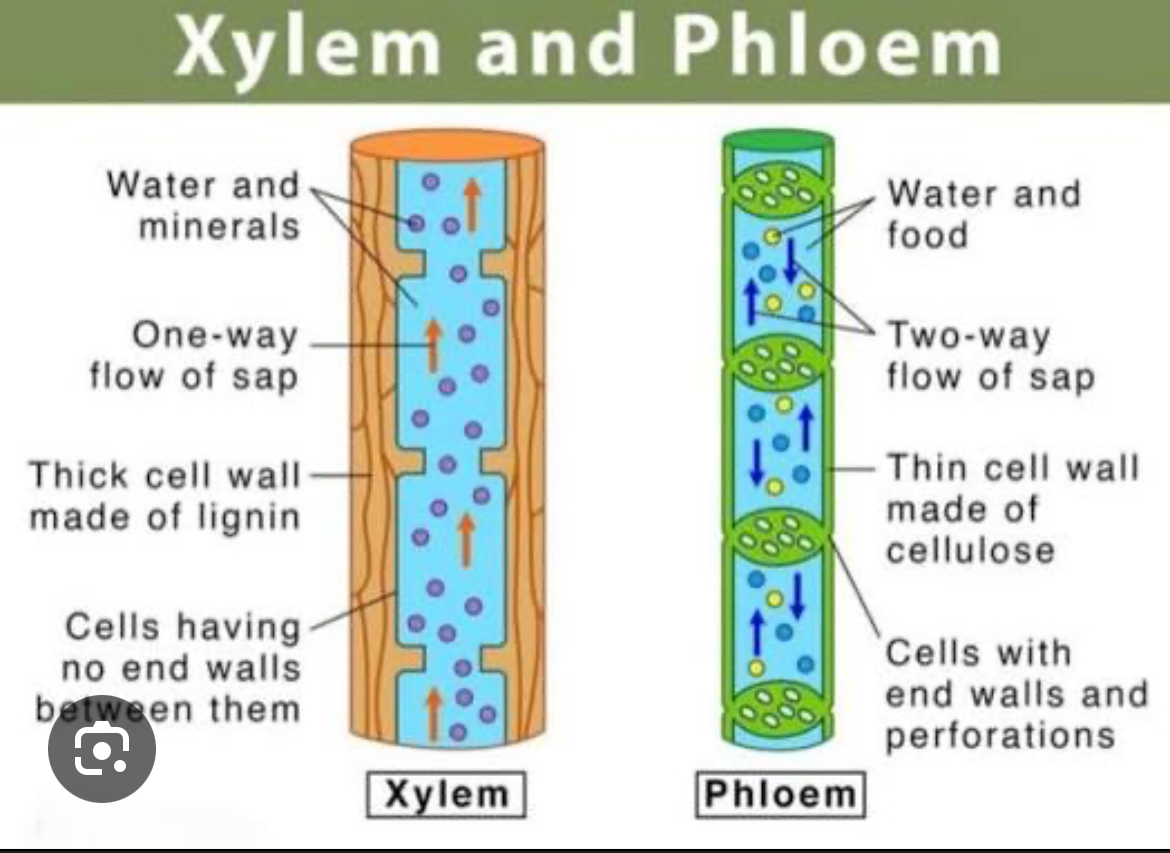
What is xylem?
Vascular tissue composed of hollow “dead” plant cells. Xylem carries ONLY water in ONE direction, up the root stem and into the leaves
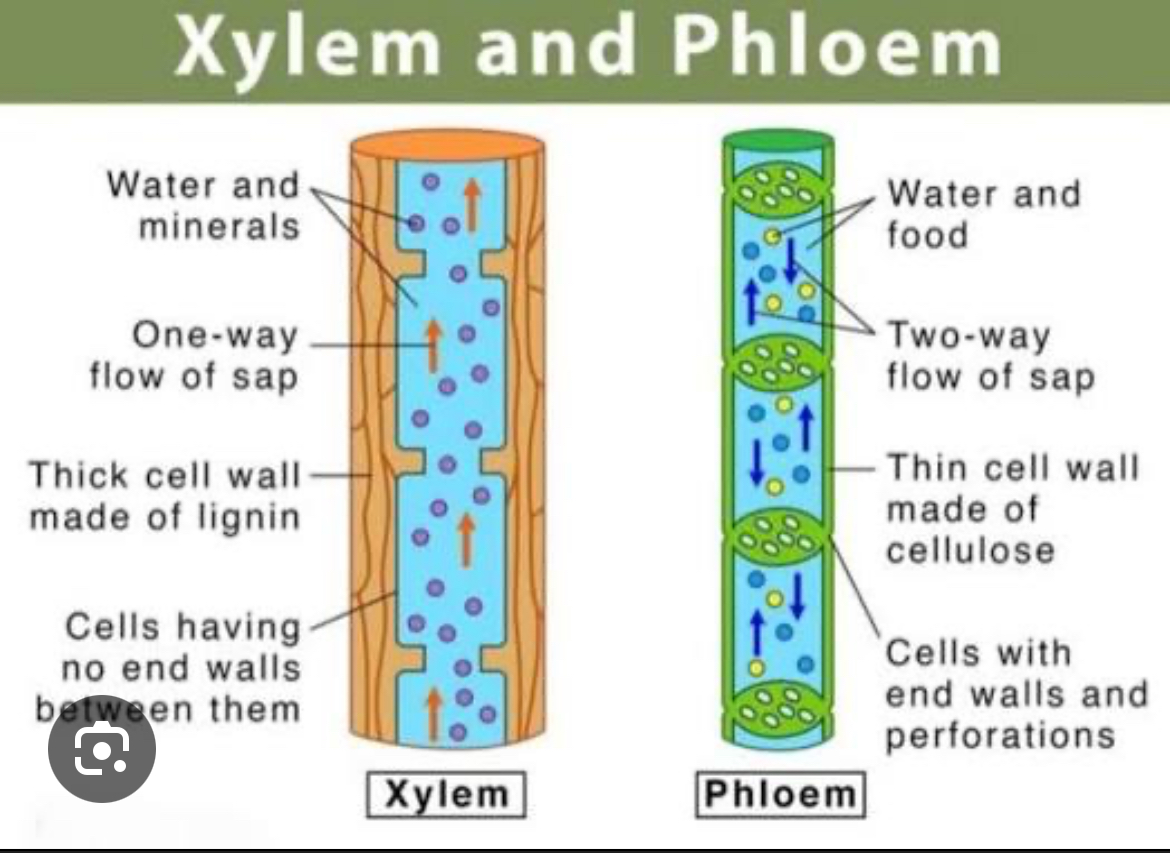
Explain cohesion and adhesion
Cohesion — When water sticks to other water molecules (H-bonds)
Adhesion — When water molecules stick to other molecules
Explain how the water “conveyor belt” works in xylem
-Water travels through xylem
-The water escapes the plant through open stomata and creates a tiny amount of negative pressure
-Water in the xylem is drawn to this negative pressure through passive transport (high pressure —> low pressure)
-The cycle continues as long as stomata are open
Explain passive transport
Water, air, etc. will always move from high to low to create equilibrium. This goes for…
Pressure
Concentration
Temperature
cold to hot(cold gases=more dense)
What is diffusion?
Passive transport of molecules from high to low concentration
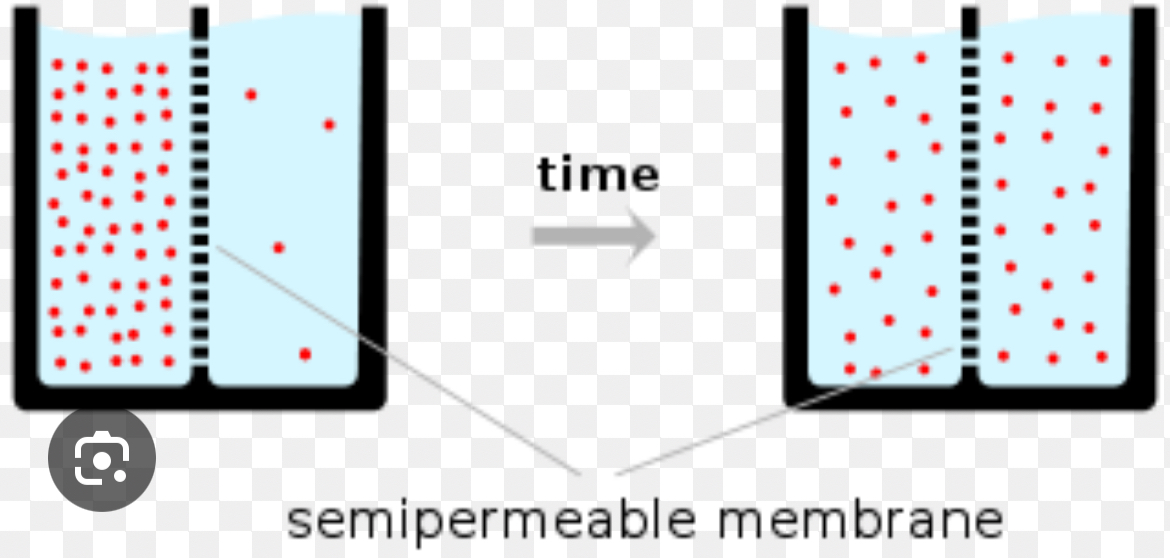
What is osmosis?
“diffusion of water”
Across a semi-permeable membrane (only water moves across)
Ex: cell membrane
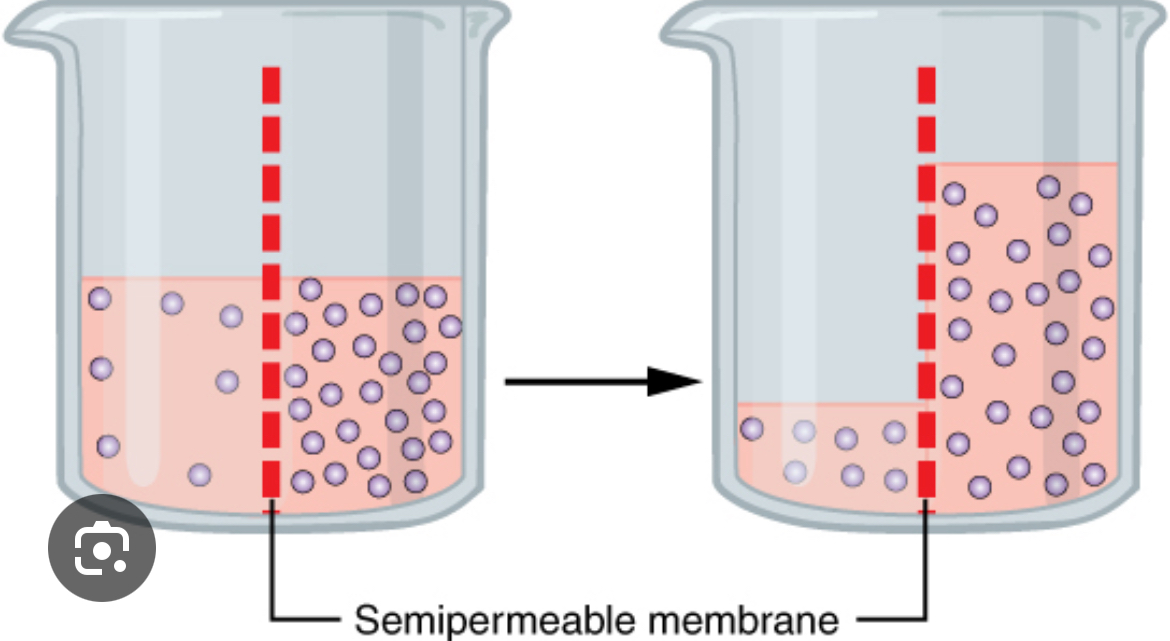
Solute vs. Solvent
Solvent = the background substance
-Ex: Water
Solute = The stuff that dissolves in the solvent
- Ex: Salt
- Diffusion is the movement of solute molecules
- Osmosis is the movement of solvent
What are Stomata? What happens when they’re open?
Tiny gaps in leaves that open and close using guard cells.
When open
Gas exchange occurs
CO2 is brought in
O2 goes out as a byproduct of photosynthesis
Water vapor escapes
What happens if stomata are closed?
Plants can conserve water, but gas exchange also can’t occur, meaning no photosynthesis
What can affect transpiration rates out of stomata?
Temp, humidity, and wind
- Hot, dry, windy environments = high transpiration rates
- Cold, wet, non-windy environments = low transpiration rates
LEAF SIZE also affects how much water escapes, small leaf = less stomata
What are the two ways plants in the sonoran desert can survive with so little rain?
Plants either have high Relative Growth Rate (RGR) or high Water-use Efficiency (WUE), this is a TRADEOFF
RGR = biomass gained/time
WUE = carbon gained (growth)/water lost
- High WUE plants conserve more water
RGR vs WUE plants and rain events
High RGR plants favor large rain events (they try to grow through their whole life span quickly)
High WUE plants favor small, frequent rain events
Explain the potential energy of atoms and electrons
Electrons closer to the nucleus of an atom (ground state) are more stable = less potential energy
Electrons farther from the nucleus are more excited = more potential energy
How do electrons become excited in photosynthesis?
Photons of light hit electrons and knock them into outer orbital shells
What is the main goal of photosynthesis?
To capture light energy and store it in glucose bonds
What are some important things to remember about carbon for photosynthesis?
C always needs 4 covalent bonds to be stable
If you take or add something to carbon (like hydrogen), you must take off or add something else
C almost never has a charge
Explain potential energy of molecules with carbon.
All bonds are covalent
- C—O
- least potential energy bc oxygen holds all electrons closely
- C—C
- Medium potential energy
- C—H
- Highest potential energy
Explain REDOX reactions
Remember “OIL RIG”
- Oxidation is losing energy
- Reduction is gaining energy
A molecule is losing energy (oxidizing) if,
- Losing hydrogen
- Losing electrons
- Adding oxygen
A molecule is gaining energy (reducing) if,
- Gaining hydrogen
- Adding electrons
- Losing oxygen
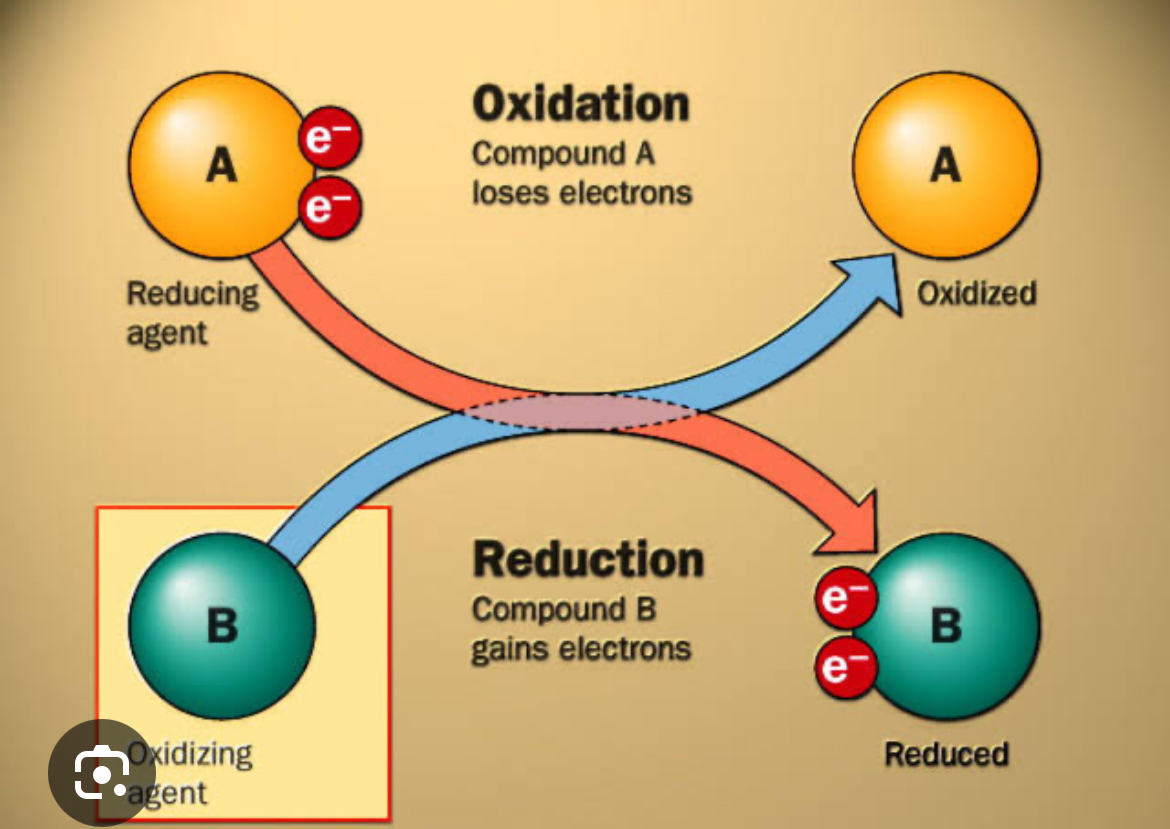
What are paired REDOX reactions?
When there are two compounds and one is being oxidized and the other is being reduced
- The oxidizing agent is stealing electrons
- The reducing agent is donating electrons
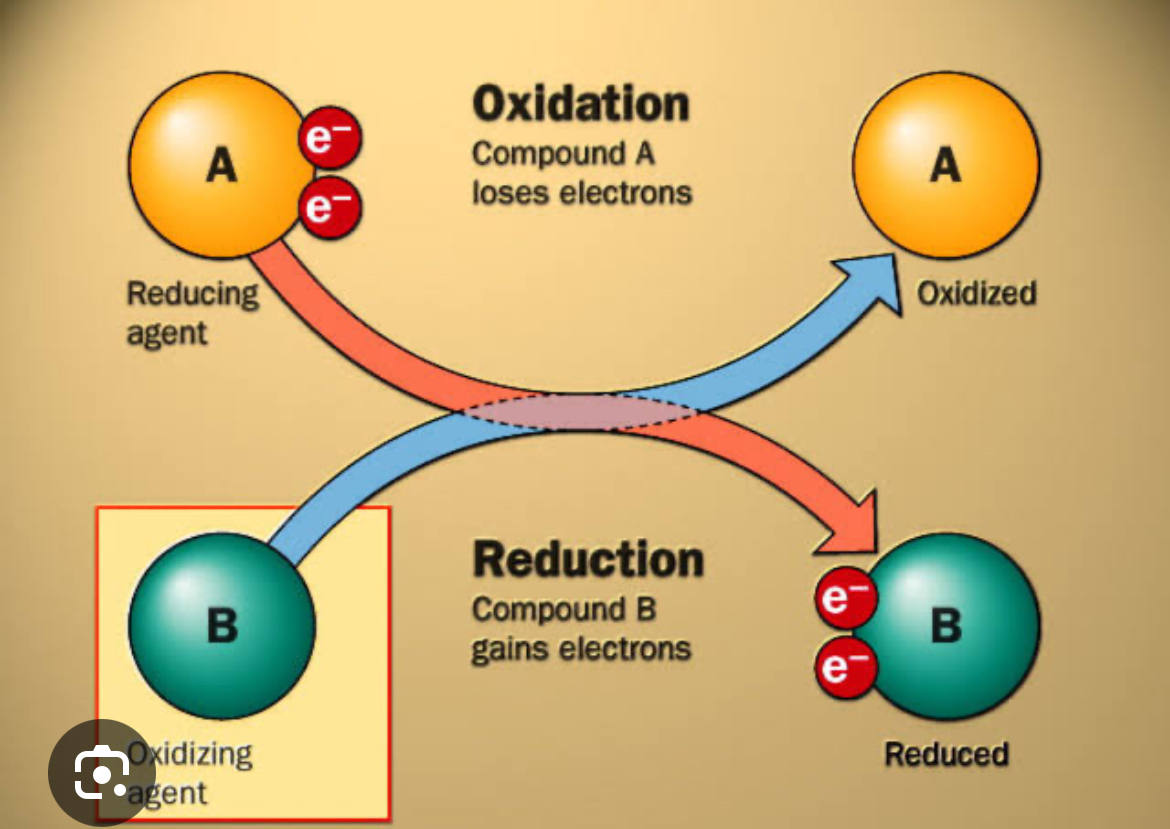
What is being oxidized and reduced in photosynthesis?
- CO2 is being reduced
- Water is being oxidized
- So low energy carbon is being turned into high energy carbon
Where does photosynthesis happen? Light reactions? Calvin cycle? ATP synthase
Photosynthesis happens in the chloroplasts
- Light reactions happen in the thylakoid membrane
- ATP synthase happens in the lumen of thylakoids
- Calvin cycle happens in the stroma of the chloroplast
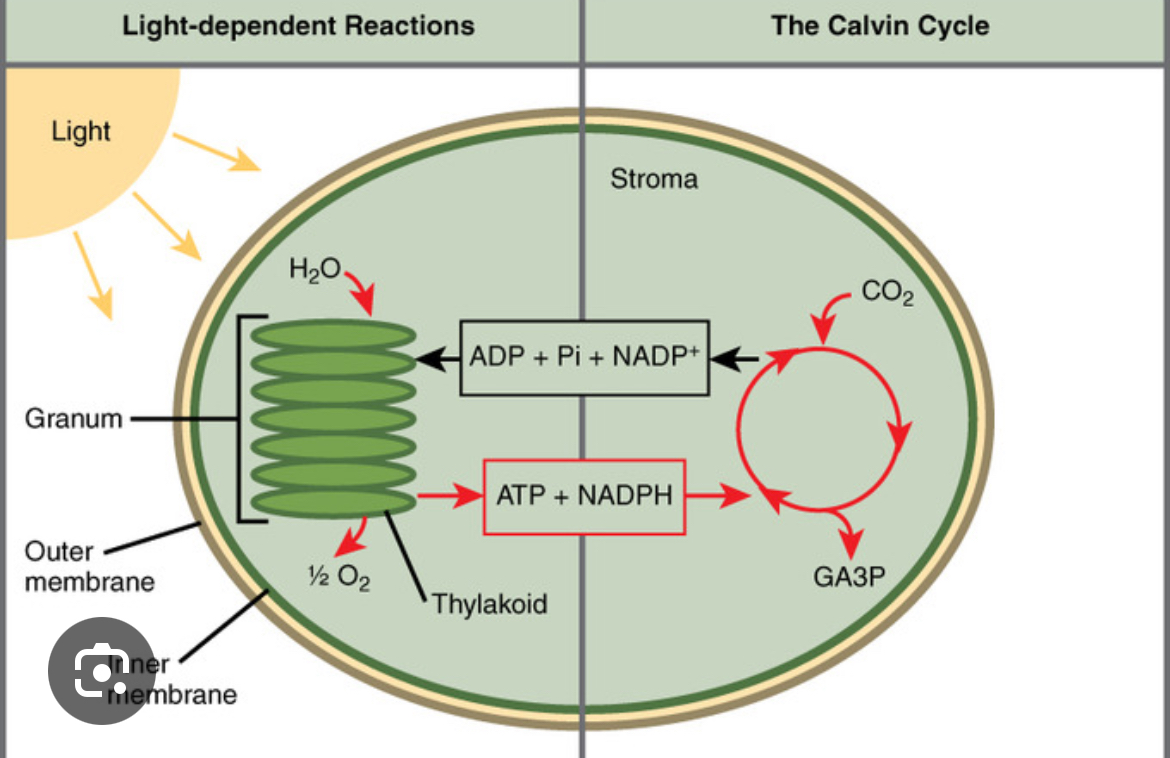
What are light absorbing pigments? Which one is important for photosynthesis?
These pigments absorb visible wavelengths of light
- Chlorophyll a is the most common in plants, it is found in the thylakoid membrane
- Chlorophyll harnesses light energy by exciting electrons and ripping apart energy to replace lost electrons
- This all happens in the photosystems
Explain what happens in Photosystem 2 during the light reactions.
1) Photons of sunlight hit chlorophyll and excite electrons
2) Excited electrons are lost to the ETC and go to photosystem 1
3) The chlorophyll replaces its lost electron by oxidizing water molecules
- This results in 2 electrons, H+ ions, and O2 (byproduct of photosynthesis)
4) The H+ ions float passively into the lumen of thylakoids
5) Once chlorophyll has its electron back the cycle can continue
What is the ETC? Why is it important?
- The Electron Transport Chain is a series of proteins that carries electrons from photosystem 2 to photosystem 1.
- The ETC also pumps H+ ions from the stroma into the lumen of thylakoids using energy from electrons
Explain what happens in photosystem 1
1) Photosystem 1 chlorophyll gets hit by a light photon and electrons are excited
2) This electron leaves chlorophyll and goes to NADP+ to form NADPH
- This process reduces NADP+, NADPH is a energy storage and transfer molecule
3) The lost electron is replaced by an electron from the ETC (from photosystem 2)
4) NADPH travels to the calvin cycle in the stroma
What is ATP synthase? Explain how it makes ATP.
- ATP synthase is an enzyme that generates ATP
- ATP synthase spans throughout the thylakoid membrane, creating transmembrane openings
- H+ ions inside the thylakoid lumen want to go into the stroma (high to low concentration), so they travel through ATP synthase
- When H+ ions travel through, they spin ATP synthase and create kinetic energy (think waterwheel)
- This kinetic energy turns ADP into ATP
- Thik of adding a phosphate group to ADP as charging a dead battery
- ATP then goes back to the calvin cycle
What is the main goal of the calvin cycle?
To use ATP and NADPH energy to convert CO2 into glucose
Explain the first step of the calvin cycle.
Carbon Fixation
1) Take RuBP (a 5-carbon sugar already in cycle) and add CO2
2) The enzyme RuBisCO helps smash these two molecules together
3) This reaction creates 2 3-carbon sugars called PGA (phosphoglycerate)
- So, one CO2 is used in this step
Explain the second step of the calvin cycle
Reduction
1) 2 PGA (3 carbon sugars) come in from fixation step
2) 2 ATP and 2 NADPH come in to energize and reduce PGA (respectively) and this forms 2 G3P (high energy carbon sugars)
3) Every 3 cycles, 1 G3P is lost from the cycle and 5 G3P are left to work with
Explain the third step of the Calvin cycle
Regeneration
1) 5 G3P come in from reduction and get converted into 3 5-carbon sugars (RuBP) using another ATP, and this RuBP goes back to fixation
How many cycles of the calvin cycle does it take to make one glucose?
How many CO2 does it take?
How much ATP and NADPH?
1) 6 cycles to create 2 excess G3P used to make one glucose
2) 6 CO2 (1 per cycle)
3) 18 ATP, 3 per cycle, 2 in reduction and 1 in regeneration
4) 12 NADPH, 2 per cycle in reduction
What is the problem with RUbisCO (what is it again?)
RUbisCO — The enzyme that combines RuBP and CO2 to create PGA in the calvin cycle
- RUbisCO can sometimes bind to O2 instead of CO2 (photorespiration)
- This is bad because it wastes AT, releases CO2, and holds onto O2 potentially causing oxygen poisoning
When is photorespiration more likely to occur?
- As temperatures increase and intercellular CO2 levels are low
- CO2 levels can decrease when stomata are closed for too long, this happens in dry places where water needs to be conserved
- Therefore, photorespiration happens more in hot and dry places (like the sonoran desert)
What are two ways plants can avoid photorespiration?
C4 or CAM photosynthesis, either don’t let RUbisCO touch CO2 or flood it with O2
Explain C4 photosynthesis
1) CO2 goes into the mesohyll of leaves (where it usually goes for C3 photosynthesis)
2) Instead of going straight to the calvin cycle, it is turned into malate (4C)
3) Malate goes to a bundle sheath cell (malate is much easier to move into these cells than CO2)
4) Malate is converted back into CO2 and the calvin cycle happens in the bundle sheath cell
- Bundle sheath cells are seperated from everything else so oxygen can’t infiltrate the calvin cycle
- C4 is only ideal for plants with enough water
Explain CAM photosynthesis
CAM
- CAM is similar to C4, except it is better at limiting water loss, so it can be done in hot AND dry places
1) CAM plants only open stomata at night, (less water lost at night). THis is when they bring in CO2
2) they fix CO2 into malware and store it in mesophyll cell vacuoles
3) During the day, malate is converted back into CO2 for the calvin cycle
4) This means RUbisCO always has access to enough CO2
- This process is much slower and not as efficient as C3 and C4 photosynthesis
Why don’t all plants do C4 and CAM photosynthesis?
Both processes take much more energy than C3 photosynthesis
What is the overarching main difference between C4 and CAM photosynthesis?
C4 photosynthesis seperates C-fixation and O2 from the calvin cycle SPATIALLY (bundle sheath cells)
CAM photosynthesis seperates C-fixation and the calvin cycle TEMPORALLY (night/day cycle)
What is a niche?
The environmental conditions and resources necessary for a species to survive and reproduce
Generally, what is the rule for two species competing for the same resource?
No two species can share the same exact resource at the same time. Eventually, one species will completely outcompete another species for a certain type of resource
How does niche partitioning make an exception for the resource competition rule?
Niche partitioning states that species CAN share resources under certain circumstances
- As long as each species is able to share some portion of the resource, its niche partioning
- Once a species is completely outcompeted for a resource, its competitive exclusion
What are the 3 different types of niche partitioning?
Temporal, spatial, and functional
Explain temporal niche partitioning.
Multiple species can share the same resource, but at different times of the day
- Ex: Hawks hunt mice during the day, and owls hunt mice at night
Explain spatial niche partitioning.
Multiple species can share the same resource, but in slightly different locations
- Ex: Different bird species can live on different parts of the same tree
Explain functional niche partitioning.
Any partitioning other than temporal or spatial
- Lions and Cheetah hunt wildebeests of different ages
Explain the two different niche sizes.
Specialists — narrow niches = specialized requirement
Generalists — wide niches = can utilize lots of different resources
- This is a gradient
Fundamental vs. realized niche
Fundamental niche — The niche that a species could potentially occupy in the absence of competition
Realized niche — The niche actually occupied by a species after competition
- Stronger competitors will occupy more of their fundamental niche